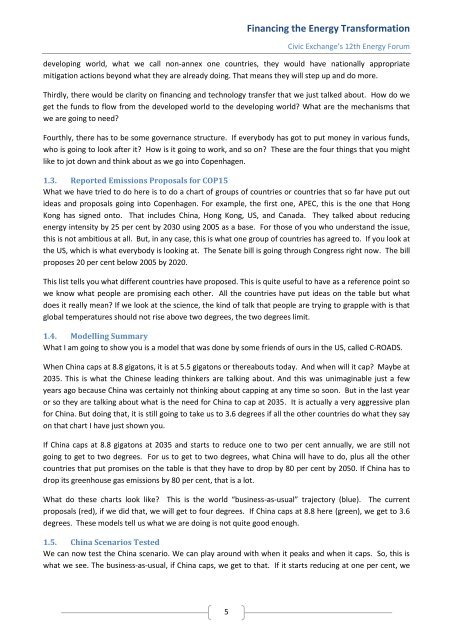Financing the Energy Transformation - Civic Exchange
Financing the Energy Transformation - Civic Exchange
Financing the Energy Transformation - Civic Exchange
You also want an ePaper? Increase the reach of your titles
YUMPU automatically turns print PDFs into web optimized ePapers that Google loves.
<strong>Financing</strong> <strong>the</strong> <strong>Energy</strong> <strong>Transformation</strong><strong>Civic</strong> <strong>Exchange</strong>’s 12th <strong>Energy</strong> Forumdeveloping world, what we call non-annex one countries, <strong>the</strong>y would have nationally appropriatemitigation actions beyond what <strong>the</strong>y are already doing. That means <strong>the</strong>y will step up and do more.Thirdly, <strong>the</strong>re would be clarity on financing and technology transfer that we just talked about. How do weget <strong>the</strong> funds to flow from <strong>the</strong> developed world to <strong>the</strong> developing world? What are <strong>the</strong> mechanisms thatwe are going to need?Fourthly, <strong>the</strong>re has to be some governance structure. If everybody has got to put money in various funds,who is going to look after it? How is it going to work, and so on? These are <strong>the</strong> four things that you mightlike to jot down and think about as we go into Copenhagen.1.3. Reported Emissions Proposals for COP15What we have tried to do here is to do a chart of groups of countries or countries that so far have put outideas and proposals going into Copenhagen. For example, <strong>the</strong> first one, APEC, this is <strong>the</strong> one that HongKong has signed onto. That includes China, Hong Kong, US, and Canada. They talked about reducingenergy intensity by 25 per cent by 2030 using 2005 as a base. For those of you who understand <strong>the</strong> issue,this is not ambitious at all. But, in any case, this is what one group of countries has agreed to. If you look at<strong>the</strong> US, which is what everybody is looking at. The Senate bill is going through Congress right now. The billproposes 20 per cent below 2005 by 2020.This list tells you what different countries have proposed. This is quite useful to have as a reference point sowe know what people are promising each o<strong>the</strong>r. All <strong>the</strong> countries have put ideas on <strong>the</strong> table but whatdoes it really mean? If we look at <strong>the</strong> science, <strong>the</strong> kind of talk that people are trying to grapple with is thatglobal temperatures should not rise above two degrees, <strong>the</strong> two degrees limit.1.4. Modelling SummaryWhat I am going to show you is a model that was done by some friends of ours in <strong>the</strong> US, called C-ROADS.When China caps at 8.8 gigatons, it is at 5.5 gigatons or <strong>the</strong>reabouts today. And when will it cap? Maybe at2035. This is what <strong>the</strong> Chinese leading thinkers are talking about. And this was unimaginable just a fewyears ago because China was certainly not thinking about capping at any time so soon. But in <strong>the</strong> last yearor so <strong>the</strong>y are talking about what is <strong>the</strong> need for China to cap at 2035. It is actually a very aggressive planfor China. But doing that, it is still going to take us to 3.6 degrees if all <strong>the</strong> o<strong>the</strong>r countries do what <strong>the</strong>y sayon that chart I have just shown you.If China caps at 8.8 gigatons at 2035 and starts to reduce one to two per cent annually, we are still notgoing to get to two degrees. For us to get to two degrees, what China will have to do, plus all <strong>the</strong> o<strong>the</strong>rcountries that put promises on <strong>the</strong> table is that <strong>the</strong>y have to drop by 80 per cent by 2050. If China has todrop its greenhouse gas emissions by 80 per cent, that is a lot.What do <strong>the</strong>se charts look like? This is <strong>the</strong> world “business-as-usual” trajectory (blue). The currentproposals (red), if we did that, we will get to four degrees. If China caps at 8.8 here (green), we get to 3.6degrees. These models tell us what we are doing is not quite good enough.1.5. China Scenarios TestedWe can now test <strong>the</strong> China scenario. We can play around with when it peaks and when it caps. So, this iswhat we see. The business-as-usual, if China caps, we get to that. If it starts reducing at one per cent, we5
















